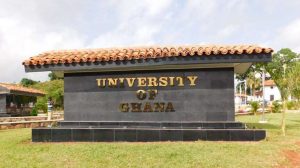The illegal gold mine is hidden just past a thick grove of cocoa trees, a little ways off the two-lane road through Sagyimase, Ghana, a rural town a couple hours’ drive north of the West African nation’s capital, Accra. It sits on a torn-up patch of ground the size of a football field, where three dozen workers operate backhoes and a tangle of generators, pumps, and hoses, washing peanut-size nuggets of gold out of the red earth.
Gold was Ghana’s biggest export last year, and mines like this are common throughout the country, often a more lucrative alternative to cocoa farming. But this mine—like too many others, government officials say—is operating without a valid permit, without oversight of its severe environmental impact, and without paying taxes meant to underwrite the land’s eventual restoration.
In Ghana’s vast agricultural hinterland, such mines often operate with little fear of regulators. Felix Addo-Okyireh, an official with Ghana’s Environmental Protection Agency who oversees the small-scale mining industry in Sagyimase and the rest of the country’s Eastern Region, has two enforcement officers patrolling an area slightly smaller than New Jersey. “It’s difficult to identify the illegal mines unless we happen to bump into them,” he says.
Mining is a big reason why Ghana has the world’s fastest-growing rate of deforestation, according to the World Resources Institute, and often leads to the contamination of farmland and water sources with toxic chemicals including mercury and cyanide. So Addo-Okyireh and his colleagues have turned to NASA for help.
Last year the Ghanaian EPA asked veteran NASA engineer Brian Killough to develop a software tool capable of identifying illegal mines from satellite photos. Killough runs the Africa Regional Data Cube, a NASA-backed initiative that aims to use open source images to track urbanization, population growth, and land-use change. His network runs mostly on shots taken from the U.S. space agency’s Landsat satellites, some of which date to the disco era and can’t register anything smaller than a baseball diamond. Still, his algorithm has used the creaky satellites to identify hundreds of locations with signs of questionable mining, such as patches of razed foliage or telltale pools of ore residue. The Ghanaian EPA has revoked licenses of 47 companies based on those and other satellite images and begun criminal prosecutions of two more, says Michael Ali, the agency’s director of mining. “The satellites have become really helpful for us,” he says. “You can see the legal mines, then you can see the ones in between and say, ‘Who is that?’”
Ghanaian President Nana Akufo-Addo temporarily banned all small-scale mining, legal or otherwise, from 2017 to this past February, so the environmental regulators have plenty of scofflaws from which to choose. Before teaming up with Killough, Ali’s staffers had painstakingly compared Google Earth images with the Ghanaian EPA’s notoriously unreliable hand-drawn survey maps. The paper surveys sometimes instructed field officers to travel to coordinates in a different country, he says, or well off the coast, somewhere in the Gulf of Guinea.
As in much of West Africa, Ghana’s illegal gold mining ranges from hand-dug holes in the forest, a practice known as galamsey (“gather and sell”), to industrialized operations that either lack proper papers or dig beyond the boundaries of their designated concession. The industry offers a tantalizing promise of quick reward to young men who have few employment alternatives—miners at the illegal spot in Sagyimase say they earn a little more than $300 per month, double the national average.
Within a few months, Killough says, he should be able to incorporate data from European Space Agency satellites into the Ghanaian EPA software, giving the agency enough eyes in the sky to detect new mining sites almost in real time. But technology can’t fix the rural poverty that drives many illegal miners or overcome the systemic pay-to-play corruption that reaches from local cops to the central government. Earlier this year, Ghanaian investigative journalist Anas Aremeyaw Anas released an exposé that included video of a federal law enforcement official accepting a bribe to help a mining company falsify its permits. “The very people you send to arrest them are the ones collaborating with them,” says Emmanuel Tabi, an elected member of the regional assembly that covers Sagyimase. Daryl Bosu, deputy director of the environmental advocacy group A Rocha, concurs: “Usually, there are no consequences.”
Workers at the illegal Sagyimase mine say they’re financed by a local small-scale mining company called Managing God’s Resources that holds several pieces of real estate in the area but lacks an active mining permit. Ibrahim Emmanuel, deputy director of the company, denies any knowledge of unlicensed mining near the company’s sites. At the mine in mid-May, workers say it’s been up and running for about a month without any interference from police. The miners’ leader, Gordan, who declined to give his surname, says he’s not worried about high-tech surveillance. The profit is worth the risk. “As long as the gold is there,” he says, “we’ll keep chasing it.”






